
Usually, the brands that are successful have already built up a good following via a D2C offering and are using Amazon as an extra channel to sell those same products.
They typically price their products at the same price as on their D2C site, or slightly higher to account for the extra costs associated with Amazon. And on average, the best sellers on Amazon usually fall in the $10-20 price range.
But you can obviously make it work around the $35-50 mark where most DTCs might be.
Also - it’s good to define what “successful” means here. We’ve worked with many D2C brands who end up driving about 40% of their revenue via Amazon - so that’s a good benchmark for what good looks like.
For one: You need to build up awareness of your brand. It helps a lot to have some search volume for your brand to start the sales volume and build “velocity”.
Next is reviews. A detailed listing page with lots of reviews converts at around 20-30%. So get lots of reviews, but be careful in managing reviews - it’s really really hard to come back from getting beat up in the reviews section.
After that you’ll need “secure inventory”: Amazon keeps a score for every product you sell called the “Sales Rank”. If you’re out of stock, your sales rank goes down.
And then the last key bit is “sales velocity”: That’s the number of transactions and dollar amount of sales that go through your Amazon profile during any given month. Your velocity is compared to other brands and products in your category or on specific search terms and that also impacts your “sales rank”.
Amazon gives you free, organic traffic all around the site. It can come in the form of search, detailed pages, emails, merchandising on the homepage, which is all personalized and custom. That free exposure + existing brand recognition + ad spend is the lethal “trifecta” which creates an ongoing loop of positive feedback & gets you to win at Amazon.
Amazon has a bunch of milestones.
The Amazon's Choice Badge is a badge that’s a function of a specific search term. This badge will only show up when people type in those specific search terms. It might show up when you go to your details page where it says you're the Amazon choice for that. But this badge means you're the highest performing product for that search term. Amazon doesn’t tell you exactly what performance is but it’s a combination of clicks and sales.
The Best Seller Badge means you're the best selling by unit velocity in your category. When you get that badge, you get rewarded for it by getting a bit more traffic. That little badge also follows you around the website everywhere you go, so people just click you more. It's this positive feedback loop. The whole thing is can you buy your way up and get these milestones where you get better rewards.

There’s a few different approaches.
For example if you’re in the probiotic supplement space, you can look up the most searched terms related to “gut health” and work back from there. You’ll be looking for keywords that have a high volume, high relevance, and low competition (low CPC).
Just make sure you actively check the existing product results for your chosen keywords - you want to make sure your product fits within the competitive landscape and can also shine as the better choice.
Another way is to look up the keywords that your closest competitors are ranking for. That might give you ideas on which products to double down on.
We use Jungle Scout for keyword research and Keepa for price & review research. And we use Perpetua to run our ads. To track overall performance and profitability, we’ve built our own tech: a Monthly P&L that shows total net profit of the channel, as well as repeat purchase dashboards that show repeat purchase, retention, and LTV, built specifically for CPG brands on Amazon. We’re starting to make this tech available to brands a la carte.
Discover new D2C brands, new eCommerce tools and read in-depth founder reviews each week.
